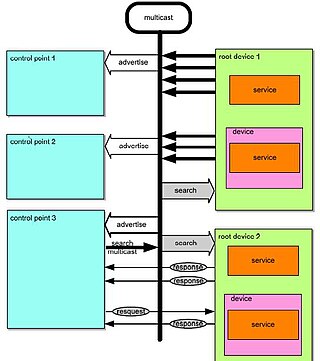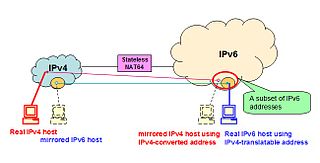Related Research Articles
An Internet Protocol address is a numerical label such as 192.0.2.1 that is connected to a computer network that uses the Internet Protocol for communication. An IP address serves two main functions: network interface identification and location addressing.

Internet Protocol version 4 (IPv4) is the fourth version of the Internet Protocol (IP). It is one of the core protocols of standards-based internetworking methods in the Internet and other packet-switched networks. IPv4 was the first version deployed for production on SATNET in 1982 and on the ARPANET in January 1983. It is still used to route most Internet traffic today, even with the ongoing deployment of Internet Protocol version 6 (IPv6), its successor.

Internet Protocol version 6 (IPv6) is the most recent version of the Internet Protocol (IP), the communications protocol that provides an identification and location system for computers on networks and routes traffic across the Internet. IPv6 was developed by the Internet Engineering Task Force (IETF) to deal with the long-anticipated problem of IPv4 address exhaustion, and is intended to replace IPv4. In December 1998, IPv6 became a Draft Standard for the IETF, which subsequently ratified it as an Internet Standard on 14 July 2017.
Classless Inter-Domain Routing is a method for allocating IP addresses and for IP routing. The Internet Engineering Task Force introduced CIDR in 1993 to replace the previous classful network addressing architecture on the Internet. Its goal was to slow the growth of routing tables on routers across the Internet, and to help slow the rapid exhaustion of IPv4 addresses.
In computing, Internet Protocol Security (IPsec) is a secure network protocol suite that authenticates and encrypts packets of data to provide secure encrypted communication between two computers over an Internet Protocol network. It is used in virtual private networks (VPNs).

Network address translation (NAT) is a method of mapping an IP address space into another by modifying network address information in the IP header of packets while they are in transit across a traffic routing device. The technique was originally used to bypass the need to assign a new address to every host when a network was moved, or when the upstream Internet service provider was replaced, but could not route the network's address space. It has become a popular and essential tool in conserving global address space in the face of IPv4 address exhaustion. One Internet-routable IP address of a NAT gateway can be used for an entire private network.

A subnetwork or subnet is a logical subdivision of an IP network. The practice of dividing a network into two or more networks is called subnetting.
In Internet networking, a private network is a computer network that uses a private address space of IP addresses. These addresses are commonly used for local area networks (LANs) in residential, office, and enterprise environments. Both the IPv4 and the IPv6 specifications define private IP address ranges.

Internet Gateway Device (IGD) Standardized Device Control Protocol is a protocol for mapping ports in network address translation (NAT) setups, supported by some NAT-enabled routers. It is a common communications protocol for automatically configuring port forwarding, and is part of an ISO/IEC Standard rather than an Internet Engineering Task Force standard.
An IPv6 transition mechanism is a technology that facilitates the transitioning of the Internet from the Internet Protocol version 4 (IPv4) infrastructure in use since 1983 to the successor addressing and routing system of Internet Protocol Version 6 (IPv6). As IPv4 and IPv6 networks are not directly interoperable, transition technologies are designed to permit hosts on either network type to communicate with any other host.

An Internet Protocol Version 6 address is a numeric label that is used to identify and locate a network interface of a computer or a network node participating in a computer network using IPv6. IP addresses are included in the packet header to indicate the source and the destination of each packet. The IP address of the destination is used to make decisions about routing IP packets to other networks.
An IPv6 packet is the smallest message entity exchanged using Internet Protocol version 6 (IPv6). Packets consist of control information for addressing and routing and a payload of user data. The control information in IPv6 packets is subdivided into a mandatory fixed header and optional extension headers. The payload of an IPv6 packet is typically a datagram or segment of the higher-level transport layer protocol, but may be data for an internet layer or link layer instead.

Carrier-grade NAT, also known as large-scale NAT (LSN), is a type of Network address translation (NAT) for use in IPv4 network design. With CGNAT, end sites, in particular residential networks, are configured with private network addresses that are translated to public IPv4 addresses by middlebox network address translator devices embedded in the network operator's network, permitting the sharing of small pools of public addresses among many end sites. This shifts the NAT function and configuration thereof from the customer premises to the Internet service provider network.
NAT64 is an IPv6 transition mechanism that facilitates communication between IPv6 and IPv4 hosts by using a form of network address translation (NAT). The NAT64 gateway is a translator between IPv4 and IPv6 protocols, for which function it needs at least one IPv4 address and an IPv6 network segment comprising a 32-bit address space. The "well-known prefix" reserved for this service is 64:ff9b::/96.
IPv4 Residual Deployment (4rd) is an IPv6 transition mechanism for Internet service providers for deployment of Internet Protocol version 6 (IPv6), while maintaining IPv4 service to customers. The protocol and sample applications are specified in RFC 7600.

IVI Translation refers to a stateless IPv4/IPv6 translation technique. It allows hosts in different address families communicate with each other and keeps the end-to-end address transparency.

dIVI Translation refers to a dual stateless IPv4/IPv6 translation technique. dIVI is an extension of 1:1 stateless IPv4/IPv6 translation with features of IPv4 address sharing and dual translation. dIVI-PD is a further extension of dIVI to be well used in Wireline and Wireless (3G/4G) access environment, where the prefix delegation is preferred. dIVI-PD is now standardized as MAP-T in the IETF.

The Address plus Port (A+P) within the network layer communications protocol for Internet networking is an experimental approach to the IPv4 address shortage. It is a technique for sharing single IPv4 addresses among several users without using stateful network address translation (NAT) in the carrier network.
Port Control Protocol (PCP) is a computer networking protocol that allows hosts on IPv4 or IPv6 networks to control how the incoming IPv4 or IPv6 packets are translated and forwarded by an upstream router that performs network address translation (NAT) or packet filtering. By allowing hosts to create explicit port forwarding rules, handling of the network traffic can be easily configured to make hosts placed behind NATs or firewalls reachable from the rest of the Internet, which is a requirement for many applications.
In order to ensure proper working of carrier-grade NAT (CGN), and, by doing so, alleviating the demand for the last remaining IPv4 addresses, a /10 size IPv4 address block was assigned by Internet Assigned Numbers Authority (IANA) to be used as shared address space. This block of addresses is specifically meant to be used by Internet service providers that implement carrier-grade NAT, to connect their customer-premises equipment (CPE) to their core routers.